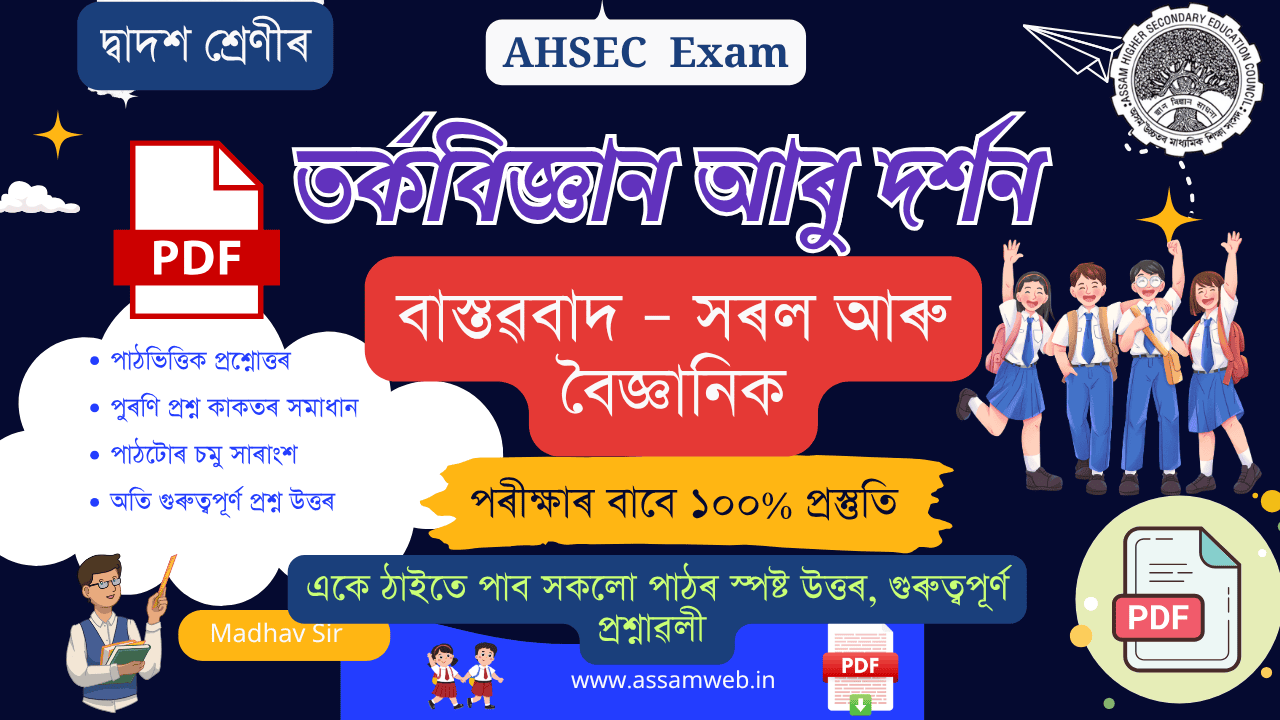Here is a comprehensive study note for the AHSEC Class 12 Finance textbook, focusing on Chapter 1: Organisation and Management of the RBI.
Chapter 1:
Organisation and Management of the RBI
Summary Note
This chapter provides a foundational understanding of the Reserve Bank of India (RBI), which is the central bank of the country.
- Establishment and Nationalisation: The RBI was constituted under the Reserve Bank of India Act, 1934, and began its operations on April 1, 1935. Initially, it was established as a shareholder’s bank. Following India’s independence, the RBI was nationalised through the Reserve Bank of India (Transfer of Public Ownership) Act, 1948. It started functioning as a state-owned and state-controlled central bank from January 1, 1949.
- Objectives of Establishment: The key objectives for the establishment of the RBI were:
- To manage the country’s monetary and credit system.
- To stabilise the internal (domestic) and external (foreign exchange) value of the Indian Rupee.
- To ensure the balanced and systematic development of the banking sector.
- To properly manage the public debt of the government.
- To centralise the cash reserves of commercial banks to maintain stability.
- To foster the development of an organised money market in India.
- Organisation and Management: The RBI’s management and organisational structure is discussed under three main heads:
- Central Board of Directors: This is the apex body responsible for the overall management of the bank’s affairs. It consists of 20 members: one Governor, not more than four Deputy Governors, four Directors (one from each Local Board), ten Directors nominated by the Central Government from various fields, and one Government Official (usually the Finance Secretary). The Governor is the Chief Executive Officer (CEO) of the bank.
- Local Boards: To represent regional interests, there are four Local Boards located in Mumbai, Kolkata, Chennai, and New Delhi. Each board consists of five members appointed by the Central Government for a four-year term. Their main function is to advise the Central Board on local matters and perform duties delegated by it.
- Offices and Administrative Departments: The head office of the RBI is situated in Mumbai. It has numerous local offices and branches in major cities across India. For smooth and efficient functioning, the RBI has established various specialised administrative departments, such as the Issue Department, Banking Department, Department of Currency Management, Exchange Control Department, and Department of Banking Operations and Development, among many others.
Complete Textual Question Answers
Here are the answers to all the questions given at the end of Chapter 1.
A. Very Short Answer Questions (1 Mark each)
- When was the RBI Act passed?
Ans: The RBI Act was passed in 1934. - When was the RBI established?
Ans: The RBI was established on April 1, 1935. - When was the RBI nationalised?
Ans: The RBI was nationalised with the passing of the RBI (Transfer of Public Ownership) Act, 1948, and it began functioning as a state-owned bank from January 1, 1949. - What is the term of office of the Governor of RBI?
Ans: The term of office of the Governor of RBI is 5 years. - What is the term of office of the Deputy Governors of the RBI?
Ans: The term of office of the Deputy Governors of the RBI is 5 years. - How many Local Boards of the RBI are there?
Ans: There are four Local Boards of the RBI.
B. Short Answer Questions (2 Marks each)
- Write the names of any two departments of the RBI.
Ans: Two important administrative departments of the RBI are:
i. Issue Department
ii. Banking Department - Write a brief note on the ‘Local Boards’ of the RBI.
Ans: The RBI has four Local Boards with their headquarters in Mumbai, Kolkata, Chennai, and New Delhi. Each Local Board consists of five members appointed by the Central Government for a term of 4 years. These boards are meant to represent regional interests and advise the Central Board on various matters referred to them. They also perform functions that the Central Board delegates to them.
C. Long Answer Questions (Type-I) (5 Marks each)
- What are the objectives of the establishment of the RBI?
Ans: The main objectives for the establishment of the Reserve Bank of India as the Central Bank of the country were as follows:- To manage the monetary and the credit system of our country.
- To stabilise the internal value and the external value of the rupee.
- For the balanced and the systematic development of the banking sector in our country.
- To manage the public debts properly.
- For centralisation of cash reserves of the commercial banks of our country.
- For the development of an organised money market in our country.
- Write a note on the ‘Central Board of Directors of the RBI.
Ans: The Central Board of Directors is the main committee for managing the affairs and business of the RBI. It consists of 20 members, which include:- One Governor: Appointed by the Central Government for a 5-year term, who acts as the Chief Executive Officer.
- Four Deputy Governors: Appointed by the Central Government for a 5-year term.
- Four Directors: Nominated by the Central Government, one from each of the four Local Boards.
- Ten Directors: Nominated by the Central Government for a 4-year period. They are experts from various fields like commerce, industries, finance, economics, and cooperation.
- One Government Official: Nominated by the Central Government, who is usually the Finance Secretary of the Government of India.
D. Long Answer Questions (Type-2) (8 Marks each)
- Describe about the organization and management of the RBI.Ans: The organisation and management of the Reserve Bank of India is a three-tiered structure designed for efficient governance and operation. It can be described under the following three heads:
- (i) Central Board: The apex of the RBI’s management is the Central Board of Directors. This 20-member board is responsible for the overall direction and supervision of the bank’s functions. It is headed by the Governor, who is the CEO, and includes up to four Deputy Governors, ten directors from various economic fields, four directors representing the Local Boards, and a government official. This composition ensures a mix of professional expertise and regional representation in policy-making.
- (ii) Local Boards: To decentralise its advisory function and incorporate regional perspectives, the RBI has four Local Boards based in Mumbai, Kolkata, Chennai, and New Delhi. Each board has five members appointed by the government. They advise the Central Board on matters of local and regional significance and handle tasks delegated by the Central Board, thus acting as a crucial link between the central management and the regional economies.
- (iii) Offices and Administrative Departments: The RBI’s head office is in Mumbai, with a network of branches and local offices in major cities across India to execute its policies and functions nationwide. The internal organisation is divided into numerous specialised departments to manage its diverse responsibilities. Key departments include the Issue Department (for currency), Banking Department, Department of Currency Management, Department of Banking Operations and Development, Exchange Control Department, and Rural Planning and Credit Department, each focusing on a specific area of the central bank’s mandate.
Previous Year AHSEC Question Answers (2015-2025)
Short Questions (1-2 Marks)
- When was RBI established? (AHSEC 2015, 2019)
Ans: The RBI was established on April 1, 1935. - Who is the present Governor of RBI? (AHSEC 2017, 2022)
Ans: The current Governor of the Reserve Bank of India is Shri Shaktikanta Das. - Where is the head office of RBI located? (AHSEC 2018)
Ans: The head office of the RBI is located in Mumbai. - In which year was the Reserve Bank of India nationalised? (AHSEC 2020)
Ans: The Reserve Bank of India was nationalised with the passing of the RBI Act in 1948, and it began functioning as a state-owned bank from January 1, 1949.
Long Questions (5-8 Marks)
- Discuss the objectives of the establishment of the Reserve Bank of India. (AHSEC 2016)
Ans: (This answer is the same as the textual Long Answer Question C.1. Please refer to that answer above). - Explain the organisational structure of the Reserve Bank of India. (AHSEC 2021)
Ans: (This answer is the same as the textual Long Answer Question D.1. Please refer to that answer above).
10 Most Important Questions in English
- When was the Reserve Bank of India established?
Ans: The Reserve Bank of India was established on April 1, 1935. - Where is the head office of the RBI located?
Ans: The head office of the RBI is located in Mumbai. - State any two main objectives for the establishment of the RBI.
Ans: Two main objectives for the establishment of the RBI are:
(a) To manage the monetary and credit system of the country.
(b) To stabilise the internal and external value of the rupee. - How many members are there in the Central Board of Directors of the RBI?
Ans: There are 20 members in the Central Board of Directors of the RBI. - When was the RBI nationalised?
Ans: The RBI was nationalised by the RBI (Transfer of Public Ownership) Act, 1948 and began functioning as a state-owned central bank from January 1, 1949. - What is the term of office for the Governor of the RBI?
Ans: The term of office for the Governor of the RBI is 5 years. - Name any two administrative departments of the RBI.
Ans: Two administrative departments of the RBI are the Issue Department and the Banking Department. - How many Local Boards does the RBI have and where are they located?
Ans: The RBI has four Local Boards, located in Mumbai, Kolkata, Chennai, and New Delhi. - In which year was the Reserve Bank of India Act passed?
Ans: The Reserve Bank of India Act was passed in 1934. - Who is the current Governor of the Reserve Bank of India?
Ans: The current Governor of the Reserve Bank of India is Shri Shaktikanta Das.


